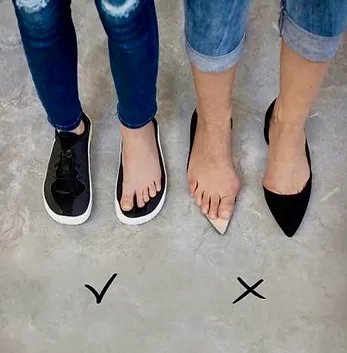Should You Wear Barefoot Shoes After 40?
Do you suffer from bunions, neuropathy, or plantar fasciitis?
Is your balance becoming increasingly concerning?
Do you have knee or back pain?
The problem might be your shoes. Here’s why.
If you're worried about your feet holding you back from living the active, healthy life you want, we'd love to help. You can sign up for a FREE 30-minute foot consultation with one of our expert doctors of physical therapy today. Simply fill out the form below and someone from our team will get in contact with you.
👇 Sign Up For A FREE 30-Minute Foot-Health Consultation 👇
The body operates by the golden rule of USE IT OR LOSE IT. In other words, if you do not regularly use a body part or function, you are communicating to your body that that part/function is unnecessary, and your body will respond by minimizing (or even eliminating) all resources devoted to maintaining that function.
Conventional shoes essentially eliminate the need for our feet by replacing each function that our feet performs. Let’s look at each function of the foot: Strength and support, mobility, sensation, balance, and posture.
STRENGTH and SUPPORT
Our feet support the weight of our entire body all day long. Literally, they keep us up and moving. To do this they need to be strong. Unless that strength and support is provided by our shoes. I used to wear highly structured, “arch support” shoes in an effort to keep my feet healthy, not realizing that I was actually leading myself down a path that leads to weakened, flat feet. Think about it. You wouldn’t wear a cast all day long for DECADES and expect your arm to stay strong would you? The more strength your shoes provide, the less strength you will have in your feet.
MOBILITY
Remember when your mom used to warn you that if you kept making that same funny face, it would get stuck there? She should have warned you instead about your feet getting stuck. Most shoes compress our feet into immovable blocks. They are made in such a way that allows us to rock from heel to toe as we walk without once changing the position of our feet. The longer our feet are held in one position, the less capable we become of changing that position. Thanks mom.
SENSATION
Did you know that there are more than 7000 nerve endings in your feet?!?! Or at least there should be. Wearing an inch to two inches of cushion under your feet all day every day insulates your feet from your environment, effectively cutting off all sensory information that your feet are SUPPOSED to feel and send to your brain. Once again, if we don’t use it, we lose it. Why should our body maintain healthy nerve endings in our feet if we aren’t using them? It won’t.
BALANCE and POSTURE
Did I just mention that we don’t get sensory information from our feet when we wear thick shoes? Well our brain uses that information to help us balance. Without it, our balance suffers. Additionally, the typical shoe squishes our toes into an UNNATURAL POSITION (bunions anyone?) which reduces our base of support, and puts us into a heel-lifted, toe-out position. This COMPLETELY throws off our posture, leading to KNEE and BACK PAIN. On top of all of that our feet are weak and immobile (voted #1 cause of plantar fasciitis)!!! Our balance doesn’t stand a chance.
The jury is in, and our “comfortable” conventional shoes are found guilty on all counts.
But do not despair! There is another way. A few brave pioneers lead the way back towards more natural foot-wear. “Minimalist” or “barefoot” shoes serve to protect the feet from hazards in our world, without depriving our feet of their natural purpose.
Here are the top 4 most important features of barefoot shoes:
They are flat, both inside and out. By flat I mean that they do have arch support, they do not have an extra thick heel, and they do not curve from heel to toe. This allows our feet to maintain the strength in our own arches, and takes us out of that “high-heeled” position that throws our alignment and posture out of whack.
They are flexible. I mean REALLY flexible. You should be able to roll your shoes up into a little ball. This will save you a lot of room in your suitcase as you travel, but more importantly it will allow your feet to MOVE as you walk, preserving the health of your joints and ligaments, and preventing that “stuck” position your mom should have warned you about.
They are relatively thin. This criteria is a little bit give and take. Thin shoes are more likely to be cold, BUT they also allow your feet to sense the world around you. Does that mean you will begin to feel the rocks you walk on? Yes. Is that uncomfortable? At first. But soon you will find that your feet acclimate to the new sensations, your circulation and nerve endings will improve, and you’ll walk straighter and softer, reducing foot, knee, and back pain.
They have a wide toe box. Feet are supposed to be roughly triangular in shape. Our toes are supposed to spread out and wiggle! A wide base of support, and toes that can spread out and stay straight keep us balanced, strong, and bunion free.
SUSAN is fixing her bunions without surgery...
Susan, a client of ours was considering a second bunion surgery for her painful feet. We encouraged her to at least get her feet strong before going under the knife. Susan transitioned to barefoot shoes, and did some basic daily exercises for her feet for a year (which included walking in her minimalist shoes and wearing toe spacers while she watched TV). Susan was able to improve the strength, circulation, and shape of her feet, and avoid a second surgery for her bunions. Check out her before and after pictures below:
Waking up one day and deciding that your life will have nothing but barefoot goodness from this day forward is a little bit like waking up and deciding that you will deadlift 200lbs, but have never even been to a gym before. Admirable, but not safe. It is important to transition slowly to natural footwear so that your body has the chance to adapt slowly and avoid injury. I recommend starting with 10 minutes a day in barefoot shoes and adding an additional 10 minutes each week, until you can comfortably wear them all day! Listen to your body. If your calves, feet, or back start to hurt beyond a general mild soreness, back off a little and go a little slower. Be patient and trust the process. Below are some strengthening and recovery exercises you can use to help you restore your foot function and get back on your feet!
If you're worried about your feet holding you back from living the active, healthy life you want, we'd love to help. You can sign up for a FREE 30-minute foot consultation with one of our expert doctors of physical therapy today. Simply fill out the form below and someone from our team will get in contact with you.









